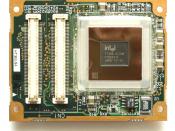While it could be argued that the development of the CPU has it's roots as far
back as 1617 with the creation of Napier's Bones, Blaise Pascal's digital adding machine
in 1642, or Charles Babbage's Difference Engine and Analytical Engine in the early
1820s - 1830s, the patent of the vacuum tube by Lee De Forest in 1906 was the actual
starting point for John Atanasoff & Clifford Berry's first electronic computer in 1937,
incorporating the binary system still in use today. The other significant pre-transistor
contribution to the history of the CPU was the Eniac, a huge, high-powered, behemoth of
a machine built by John Mauchly and J. Presper Eckert in 1946.
The invention of the transistor (short for "transfer resistance") by John Bardeen and
Walter Brattain in 1947 was perhaps the single, foremost contribution to the development
of the CPU & 2nd generation computers. Another tremendous step forward in the
development of the CPU & the 3rd generation of computers was the invention of the
integrated circuit (IC) in 1959 by Jack Kilby at Texas Instruments September 12, 1958.
That same year Robert Noyce's practical integrated circuit, invented at Fairchild Camera
& Instrument Corp., allowed printing of conducting channels directly on the silicone
surface. The IC was a collection of transistors on a semiconductor base (or substrate
material) connected without wires, enabling the use of many more transistors in a very
small area.
With the advent of the integrated circuit, the next 10 - 12 years would be a race
to develop the Central Processing Unit (CPU) with a number of different competitors
trying to be the first to corner the market on this new technology in its infancy. Work
begins on the creation of the 1st commercially available microprocessor, the 4004, in
early 1970 and in December...


